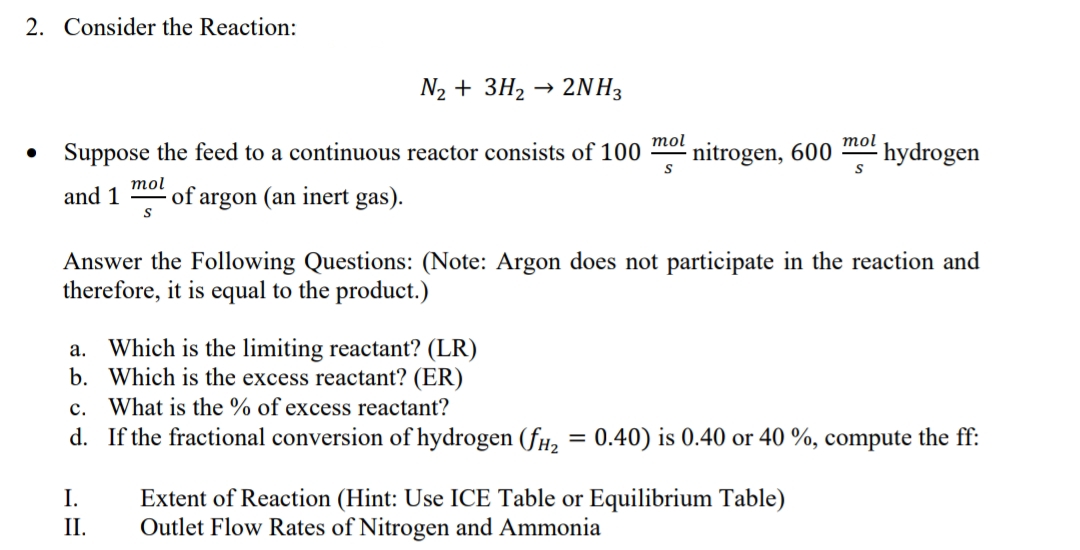2. Consider the Reaction: N2 + 3H2 → 2NH3 mol Suppose the feed to a continuous reactor consists of 100 nitrogen, 600 mol hydrogen mol and 1 of argon (an inert gas). Answer the Following Questions: (Note: Argon does not participate in the reaction and therefore, it is equal to the product.) a. Which is the limiting reactant? (LR) b. Which is the excess reactant? (ER) c. What is the % of excess reactant?
2. Consider the Reaction: N2 + 3H2 → 2NH3 mol Suppose the feed to a continuous reactor consists of 100 nitrogen, 600 mol hydrogen mol and 1 of argon (an inert gas). Answer the Following Questions: (Note: Argon does not participate in the reaction and therefore, it is equal to the product.) a. Which is the limiting reactant? (LR) b. Which is the excess reactant? (ER) c. What is the % of excess reactant?
General Chemistry - Standalone book (MindTap Course List)
11th Edition
ISBN:9781305580343
Author:Steven D. Gammon, Ebbing, Darrell Ebbing, Steven D., Darrell; Gammon, Darrell Ebbing; Steven D. Gammon, Darrell D.; Gammon, Ebbing; Steven D. Gammon; Darrell
Publisher:Steven D. Gammon, Ebbing, Darrell Ebbing, Steven D., Darrell; Gammon, Darrell Ebbing; Steven D. Gammon, Darrell D.; Gammon, Ebbing; Steven D. Gammon; Darrell
Chapter6: Thermochemisty
Section: Chapter Questions
Problem 6.101QP: Formic acid, HCHO2, was first discovered in ants (formica is Latin for ant). In an experiment, 5.48...
Related questions
Question
PS2. Kindly answer this and show your solution.

Transcribed Image Text:2. Consider the Reaction:
N2 + 3H2 → 2NH3
mol
Suppose the feed to a continuous reactor consists of 100
nitrogen, 600
mol
- hydrogen
тol
and 1
of argon (an inert gas).
Answer the Following Questions: (Note: Argon does not participate in the reaction and
therefore, it is equal to the product.)
Which is the limiting reactant? (LR)
b. Which is the excess reactant? (ER)
c. What is the % of excess reactant?
d. If the fractional conversion of hydrogen (fH, = 0.40) is 0.40 or 40 %, compute the ff:
а.
%3D
Extent of Reaction (Hint: Use ICE Table or Equilibrium Table)
Outlet Flow Rates of Nitrogen and Ammonia
I.
II.
Expert Solution
This question has been solved!
Explore an expertly crafted, step-by-step solution for a thorough understanding of key concepts.
This is a popular solution!
Trending now
This is a popular solution!
Step by step
Solved in 4 steps with 4 images

Knowledge Booster
Learn more about
Need a deep-dive on the concept behind this application? Look no further. Learn more about this topic, chemistry and related others by exploring similar questions and additional content below.Recommended textbooks for you

General Chemistry - Standalone book (MindTap Cour…
Chemistry
ISBN:
9781305580343
Author:
Steven D. Gammon, Ebbing, Darrell Ebbing, Steven D., Darrell; Gammon, Darrell Ebbing; Steven D. Gammon, Darrell D.; Gammon, Ebbing; Steven D. Gammon; Darrell
Publisher:
Cengage Learning

Chemistry & Chemical Reactivity
Chemistry
ISBN:
9781337399074
Author:
John C. Kotz, Paul M. Treichel, John Townsend, David Treichel
Publisher:
Cengage Learning

Chemistry & Chemical Reactivity
Chemistry
ISBN:
9781133949640
Author:
John C. Kotz, Paul M. Treichel, John Townsend, David Treichel
Publisher:
Cengage Learning

General Chemistry - Standalone book (MindTap Cour…
Chemistry
ISBN:
9781305580343
Author:
Steven D. Gammon, Ebbing, Darrell Ebbing, Steven D., Darrell; Gammon, Darrell Ebbing; Steven D. Gammon, Darrell D.; Gammon, Ebbing; Steven D. Gammon; Darrell
Publisher:
Cengage Learning

Chemistry & Chemical Reactivity
Chemistry
ISBN:
9781337399074
Author:
John C. Kotz, Paul M. Treichel, John Townsend, David Treichel
Publisher:
Cengage Learning

Chemistry & Chemical Reactivity
Chemistry
ISBN:
9781133949640
Author:
John C. Kotz, Paul M. Treichel, John Townsend, David Treichel
Publisher:
Cengage Learning

World of Chemistry
Chemistry
ISBN:
9780618562763
Author:
Steven S. Zumdahl
Publisher:
Houghton Mifflin College Div